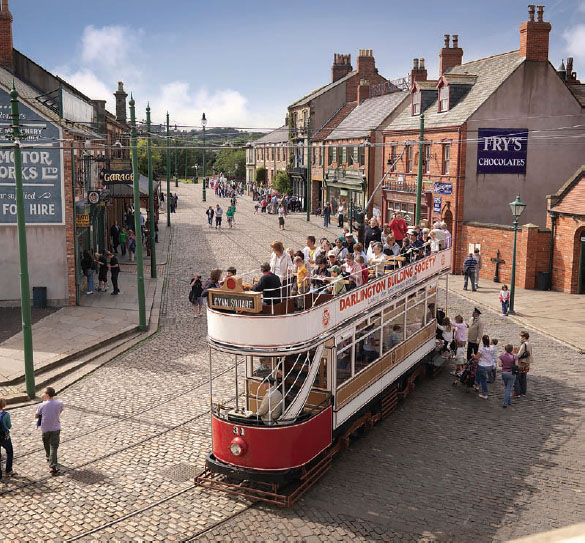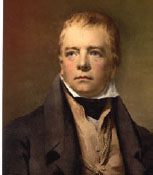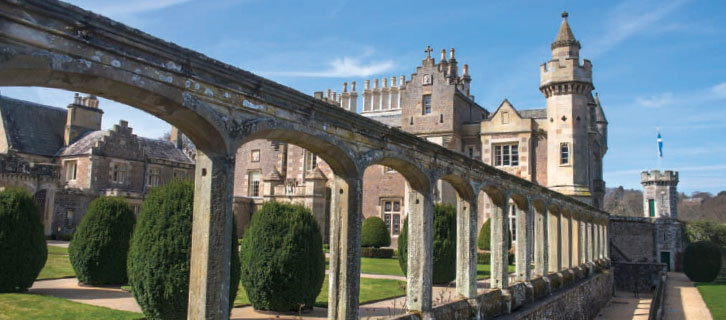
Northumbria and the Scottish Borders
Feudal castles and ancient abbeys, desolate moorlands and sweeping coastal vistas: England’s far North Country and the Scottish Borders is a land of turbulent history and stark, stately landscapes. Here is one of our favorite road trips—a diverse, sparkling introduction to the ancient kingdom of Northumbria, across the Pennines to the border country north of the River Tweed.
DAY 1 — TAKE THE TRAIN TO DURHAM
CATCH A TRAIN from King’s Cross this morning, traveling north in comfort to the ancient city of Durham. Pious monks escaping the Vikings brought St. Cuthbert’s bones here in 995 and built around them what became Durham Cathedral high above the River Wear. Durham Cathedral and its adjacent castle were the fortresses of church and state in the North Country. From 1075 until 1836, the Bishop of Durham held the title of Prince Bishop, and virtual autonomy in governing the sparse, sprawling country that served as a buffer between England and Scotland.
An early afternoon arrival here allows time to explore this seat of the Prince Bishops: majestic Durham Cathedral with its 900 years of history, Durham Castle and the River Wear. Take in the narrow streets around Palace Green, the Market Place and historic St. Nicholas Church. There are plenty of options for accommodations in the center city. The Durham tourism website offers a great resource at www.thisisdurham.com.
DAY 2 – LIVING HISTORY AT BEAMISH
TAKE TO THE ROAD TODAY with a rental car easily available in Durham. Get an entirely different view of Northern life with a visit to Beamish, the Living Museum of the North, just a dozen miles up the A167 near Chester-le-Street. It’s one of the great open-air museums of Europe. Northern England’s social and industrial history is brought to life in the farms, early 1900s town and colliery village at this award-winning re-creation and restoration.
[caption id="LandofPrinceBishopsandBorderLords_img2" align="aligncenter" width="586"]

VISITENGLAND/DIANA JARVIS
On your return to Durham, you might detour a couple of miles on the A6127 to see the famous Angel of the North sculpture on the A1 near Gateshead. With time in Durham, there is shopping in the Market Place, or stroll the Riverside Walk along the Wear. Durham is an ancient university town as well. Durham University’s Oriental Museum and Botanic Garden both merit visits. You might also take in the majestic choral evensong at Durham Cathedral at 5:15 p.m. Dining options and evening entertainment abound in the university city.
[caption id="LandofPrinceBishopsandBorderLords_img3" align="aligncenter" width="585"]

VISITENGLAND/DIANA JARVIS
DAY 3 – HADRIAN’S WALL AND THE SCOTTISH BORDER CROSSING
TURN NORTH into the wilds of Northumbria this morning, following the A68 to the prized market town of Hexham and Hexham Abbey. Then, visit the Roman fort at Housesteads along Hadrian’s Wall for a look at life 2,000 years ago on the furthest outpost of the Roman Empire. Regain the A68 north across the bleak Cheviot Hills of Northumberland National Park and Redesdale Forest into Scotland’s Border Country.
This afternoon, visit the first of four famous medieval border abbeys, Jedburgh Abbey, before continuing on the A698 to the market town of Kelso. Only the standing gatehouse and a few shards of wall remain of Kelso Abbey. An alternative base might be the quieter village of Melrose. Both have a variety of well-located lodgings. You can check out accommodation for either town at www.visitscotland.com.
DAY 4 – SIR WALTER SCOTT COUNTRY

VISITENGLAND/DIANA JARVIS
Explore the old village of Melrose as well; this is the quintessential Border town. Melrose Abbey is the prettiest of the Border Abbeys, and where the heart of Robert the Bruce lies. On the scenic return to Kelso, visit Dryburgh Abbey, fourth and largest of the Border Abbeys. Scott’s honored tomb lies here, where he was buried in 1832.
There is plenty to explore in the shops, restaurants and townscapes of Kelso. For the best view of local culture (and perhaps music), seek out a pub or two this evening.
[caption id="LandofPrinceBishopsandBorderLords_img5" align="aligncenter" width="726"]

LIBRARY OF CONGRESS
DAY 5 – ALONG THE TWEED AND SOUTH TO ALNWICK
Turn east this morning, following the River Tweed on the A698. Take a morning stop perhaps to look around the pretty town of Coldstream, original headquarters of the Coldstream Guards in 1659. We’ll follow the river to its North Sea mouth at Berwick-Upon-Tweed. Berwick’s 16th-century ramparts still standing, the historic seaport of Berwick has switched allegiance between England and Scotland many times over the centuries. You might detour a few miles south to visit Etal Castle and its great display on the nearby battlefield of Flodden, where the “flower of Scottish nobility” was cut down in 1349. Check out the battlefield yourself.
This afternoon, turn south again into Northumbria and follow the A697 south, to the Northumbrian market town of Alnwick. There should be time for tea or a pint, and a look around the town that grew up in the shadow of Alnwick Castle. The classic place to stay is the White Swan Hotel, with its 300 years of history, but there is a range of choices.
[caption id="" align="alignnone" width="733"]

VISITSCOTLAND/KENNY LAM
DAY 6 – ALNWICK AND HOLY ISLE
PLAN TODAY with reference to the local tides. Morning or afternoon, depending, cross the causeway along the coast to Lindisfarne, often called Holy Island (see Scott Reeves’ story “Notes from Small Islands,” May/June). Missionaries from the Hebrides settled here in 635. Home of the famed Lindisfarne Gospels and one of the earliest Christian settlements in England, the ruin of the Benedictine priory dominates a stark island teeming with bird life.
Do visit 16th-century Lindisfarne Castle as well, remade into a Victorian mansion by Sir Edwin Lutyens.
Time permitting, take the coast road (B3142) south past magnificent Bamburgh Castle (pay a visit if it’s open). Pause perhaps for tea in the pretty, if chilly, North Sea beach town of Seahouses. This is the scenic Northumbrian coastline at its best. You can thread back to the A1 at several points south. An afternoon return brings a visit to famed Alnwick Castle, home of the Duke of Northumberland (and its unusual gardens), with time to shop or wander and investigate this ancient market town. Of course, if the tides favor it, visit Alnwick Castle in the morning and head to Lindisfarne Island after lunch.
DAY 7 – THE END OF ALL GOOD THINGS
IF IT’S TIME to return to London, this morning drop off the rental car in Durham (perhaps even Newcastle) and catch a train for London King’s Cross. If you have a few more days, take the train north to Edinburgh for a day or two in the Scottish capital, or jump out in York on the way south for a microcosm of northern England’s history. Of course, from Peterborough to Berwick, every stop the train makes holds a wealth of discoveries.





Comments